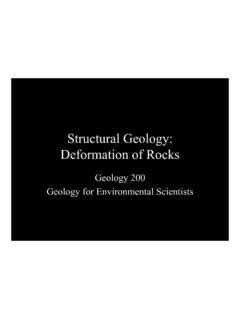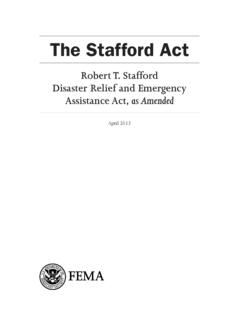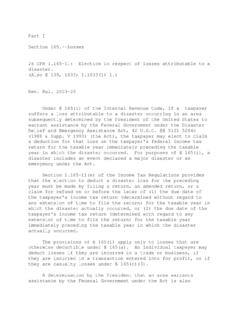Transcription of ASCE 7-16 Seismic Provisions Overview
1 12/12/2017. ASCE 7-16 Seismic Provisions Overview John Hooper, , Senior Principal/Director of earthquake Engineering Magnusson Klemencic Associates New Site Amplification Factors First update since 1994 UBC. Much more data! Fa and Fv range between 80% 120% of previous values Site Class D is no longer the default site class Fa (Site Class C controls in high shaking areas). 1. 12/12/2017. 2. 12/12/2017. 3. 12/12/2017. 4. 12/12/2017. 5. 12/12/2017. Background for Section Requirement Use of only two response periods ( and ) to define ELF. (and MRSA) design forces is not sufficient, in general, to accurately represent response spectral acceleration for all design periods Reasonably Accurate (or Conservative) When peak MCER response spectral acceleration occurs at or near and peak MCER response spectral velocity occurs at or near for the site of interest Potentially Non conservative When peak MCER. response spectral velocity occurs at periods greater than for the site of interest ( , softer soil sites whose Seismic hazard is dominated by large magnitude events).
2 6. 12/12/2017. Example ELF Design Spectrum based on ASCE 7 16. (Revised) Site Factors earthquake ground motions at RX = km, Site Class D/E. New Site Specific Ground Motion Requirements Now required for the following site conditions: Structures on Site Class E sites with Ss Structures on Site Class D & E sites with S1 However, exceptions to requiring site specific spectra provided if higher Values of Fa or Cs are used 7. 12/12/2017. New Site Specific Ground Motion Requirements Exceptions: Structures on Site Class E sites with Ss , provided Fa taken as from Site Class C. Structures on Site Class D & E sites with S1 , provided Cs is determined by Eq. 2 for T and taken as times value computed by Eq. 3 for TL T > or Eq. 4. for T > TL. Structures on Site Class E with S1 , provided T Ts and ELF is used for the analysis New Vertical Ground Motions Section provides OPTIONAL vertical ground motions in lieu of Section (Ev) for SDC C through F.
3 Initially developed for the 2009 NEHRP Provisions Keyed to SMS (MCER level ground motions). Design spectrum taken as 2/3 MCER spectrum 8. 12/12/2017. New Vertical Ground Motions Chapter 12 Changes 9. 12/12/2017. Seismic Load Combinations Expanded Seismic load combinations in Sections and moved to Chapter 2. Seismic load effects definitions remain in Section (E, Eh, Ev, Em, Emh, and 0). Seismic Load Combinations Introduces a new term, Ecl: The capacity limited horizontal Seismic load effect, equal to the maximum force that can develop in the element as determined by rational, plastic mechanism Analysis Emh = 0QE need not be taken as larger than Ecl 10. 12/12/2017. Updated Requirements for Determination of Cs and Ev for short, regular structures Section allows SDS = but not less than 70% of SDS. defined in Section No irregularities Does not exceed five stories T < Meets the requirements for = Risk Category I and II.
4 Accidental Torsion Change Section requires accidental torsional moments (Mta) be applied for determination of horizontal irregularities Mta need NOT be included when determining the Seismic forces E for: Design of the structure Determination of design story drift Except for two important cases . 11. 12/12/2017. Accidental Torsion Change These two cases are: 1. Structures assigned to Seismic Design Category B with Type 1b horizontal irregularity 2. Structures assigned to Seismic Design Category C, D, E, and F with Type 1a and Type 1b horizontal structural irregularity New Diaphragm Requirements Section required for precast concrete diaphragms; alternative for others Complete new formulation Includes potential reduction for diaphragm ductility Based on analytical and physical research 12. 12/12/2017. New Diaphragm Requirements Change also requires the use of 0 for transfer diaphragms (Horizontal Irregularity Type 4 Out of Plane Offset).
5 Increased by 0. Modifications to Modal Response Spectrum Analysis Method Modified to require 100% of the mass Introduces rigid body mode concept for T< Exception allows 90% of mass as currently done 15% scaling reduction relative to ELF results is eliminated; must scale to 100% of ELF results 13. 12/12/2017. Linear Response History Analysis Added to Section Advantage of LRHA vs. MRSA. The algebraic signs of all forces and deformations are retained in LRHA; The signs are lost in the modal combinations used in MRSA. Concurrency of actions (axial force and bending moment) are retained in LRHA. Recovery of concurrent actions is not possible in MRSA. LRHA Modeling Requirements The structure must be modeled in three dimensions This is also required in MRSA. Where required, accidental torsion must be represented by use of mass offsets This is necessary to retain algebraic signs and concurrency of force. 14. 12/12/2017.
6 LRHA Modeling Requirements P Delta effects must be included in the analytical model This allows of the inclusion of P Theta Effects (amplification of global torsional response). Not less than three sets of Spectrum Matched ground motion must be used. The ground motions are tightly matched to the same spectrum used in MRSA. LRHA Ground Motions Spectrally Matching Ground Motion Records TLower TUpper +/ 10% Match Original Unmatched Matched 15. 12/12/2017. LRHA Scaling Two analyses (X and Y) are run independently for each ground motion set and scaled to 100% of ELF Base Shear E1_X E1_Y. Basic Analyses Used to Determine Scale Factors X and Y. LRHA Values used for Design Forces and displacements (story drifts) used for design are based on envelope quantities from all analyses. Envelope values need to be used where interaction of forces is important ( , columns and walls). 16. 12/12/2017. Strength Design Alternative for Foundations New Section Strength Design for Nominal Foundation Geotechnical Capacity Used when Strength Load Combinations are applied in design Foundation Capacity, Qus, determined by geotechnical engineer Strength Design Alternative for Foundations 17.
7 12/12/2017. New Structural Requirements for Sites Susceptible to Liquefaction Current Section requires geotechnical investigation, including liquefaction and lateral spreading New Section provides design requirements Shallow Foundation Design Deep Foundation Design Section Shallow Foundations Buildings permitted to be supported on shallow foundations provided: 18. 12/12/2017. Section Shallow Foundations Shallow foundations meeting differential settlement criteria need only need to follow deem to comply detailing Individual footing ties: Ftie = Pu Footings integral with minimum 5 slab on ground with > Mat foundations need to be designed to accommodate expected vertical differential settlements Section Deep Foundations Design requirements to account for Downdrag demands Reduced lateral resistance Concrete pile detailing (ACI reference). Lateral spreading affect on piles deformations and demands Foundation ties 19.
8 12/12/2017. New Seismic Design Maps: Based on USGS's 2014 National Seismic Hazard Maps New/updated fault characterizations New Ground Motion Prediction Equations Changes also resulting from fragility curve modification (changed from to ). Changes in MCER and MCEG Values 20. 12/12/2017. Chapter 13 Changes: Nonstructural Components Some Highlights Distribution systems New definition: DISTRIBUTION SYSTEM: An interconnected system of piping, tubing, conduit, raceway, or duct. Distribution systems include in line components such as valves, in line suspended pumps, and mixing boxes. Complete overhaul of Provisions addressing these systems. New provision 7. under Exemptions In line components such as valves, in line suspended pumps, and mixing boxes that require independent support are discrete components that must be braced considering the tributary contribution of the attached distribution system. 21. 12/12/2017.
9 Distribution systems Revision of the 20 lb/400 lb exemptions for mechanical and electrical (M&E) components: In SDC C, M&E are exempted if either Ip = 1 and the component is positively attached* to the structure, OR if the component weighs less than 20 lb or, if a distribution system, weighs less than 5 lb/ft. *Positive attachment: Understood to not be friction or adhesion based. Typically bolts, screws, anchors. Distribution systems In SDC D, E and F, discrete M&E components are exempted if they are positively attached AND: the component is 400 lb or less, the center of mass is 4 ft or less above the adjacent floor level, flexible connections are provided, and Ip = 1; or the component is 20 lb or less; or the distribution system is 5 lb/ft or less 22. 12/12/2017. Overstrength, Vertical Force, Vertically Cantilevered Systems . ASCE 7 10. Incorrectly interpreted as applying only to vertically cantilevered systems.
10 Overstrength, Vertical Force, Vertically Cantilevered Systems . ASCE 7 16. The overstrength factor, 0, in Table and Table , is applicable only to anchorage of components to concrete and masonry where required by Section or the standards referenced therein and shall be applied in accordance with Section The redundancy factor, , is permitted to be taken equal to 1 and the overstrength factors in Table need not apply. The force (Fp) shall be applied independently in at least two orthogonal horizontal directions in combination with service or operating loads associated with the component, as appropriate. For vertically cantilevered systems, however, the force Fp, shall be assumed to act in any horizontal direction. Vertical Force. In addition, tThe component shall be designed for a concurrent vertical force The redundancy factor, , is permitted to be taken equal to 1 and the overstrength factor, 0, does not apply.






